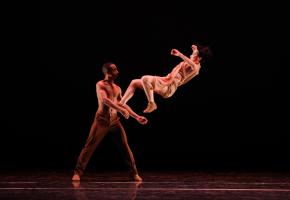If you thought Argentina only produced the TANGO, then think again. While the people in the docklands of Buenos Aires were developing the Tango, out in the rural back lands, the ‘gaucho’ was creating his own powerful dance, the ‘Malambo’. Other Argentine folkloric dances tend to be more gentle affairs, with partners and gentille gestures, reminiscent of minuets and other European imports. The ‘Malambo’ on the other hand, is a dance that grew organically out of the land, and that primal quality is still there. The Incas (from the North) and Araucanos (from the Southern Andes and Patagonia) had dances involving fancy footwork and the rhythmic clapping of hands. The combination of these elements with influences from Spain (Flamenco) and Russia, thanks to immigration in the 19th century, the Malambo developed into the ‘gaucho’s’ dance par excellence with its own very personal attitudes and character.
This is a macho dance, for men and by men. It allows the men to expresses themselves. It is often danced by one person alone, yet it is very macho, overflowing with testosterone and the most basic elements of rivalry and competition between men. With acrobatic movements and astounding footwork to superb drumming rhythms, the men dance to dialogue, joke or challenge each other on stage. Reminiscent of ‘Capoeira,’ the fight-dance of Brazil, it introduces echoes of tribal warfare and fighting. If only it were always this beautiful.
Forget Poldark or Daniel Craig, here is manhood in full splendour and beauty.
The ‘Bombo Legüero or Criollo’ is a drum that forms an intrinsic part of this dance (and most Argentine Folklore) with its deep and dark resonance, contrasting with the higher pitched effect of the drumsticks beating the wood on the top and sides of the drum, creating highly complex rhythms, all versions of ¾ time, altered by the varied syncopation and accents.
Each Bombo drum is carved out of a single ‘Seibo’ tree trunk. Thanks to its wood being slightly porous, it provides an echo quality that produces the distinctive sound. Called ‘Legüero’ for ‘League’ this drum was originally created for ‘communication’, as its sound could travel many leagues in distance, to announce a funeral or a fiesta to call people to the village. But man being an artist at heart, they soon found a way to use it to create music.
The ‘gauchos’, often mestizos, (mixed with Indian blood), were traditionally nomadic and travelled the pampa looking for work (on horseback only) with their own troops of horses and lead mare. It was a brutal and hard life, with a poncho for a blanket, the saddle for a headrest and the stars for a roof.
The ‘Boleadoras’, that form an important part of the dance and the show, were originally an Indian weapon. Three leather bound stones of about 10cm in diameter, were tied together at end of 3 woven-leather ropes. Used like a lasso to trap guanaco and ñandú, the South American Ostrich or Rhea, (and probably people in warfare), this useful and effective weapon was rapidly adopted by the gauchos, By swinging it over your head like a lasso, you can fling it towards your prey and the weight makes the stones wrap around its legs bringing it down.
This troupe is particularly skilful with the tradition of using the ‘Boleadoras’ as a part of the Malambo dance. Despite some early set-back on their use, so popular in rural areas, but not so much in Buenos Aires, it finally became an intrinsic part of the show. Walter Kochanoski, one of the soloists of ‘Che Malambo’ comments: -
“The Boleadoreas had a bad reputation. I remember that the first ‘Malambistas’ said that they were only for the circus and were insistent that it was against the traditions of the dance. You did not see it much in Buenos Aires, probably because few people knew how to use them, so they mistrusted their use and they felt the Malambo should only have the ‘zapateo’ footwork. Nevertheless, apart from being astounding, the boleadoras are super visual!”
The dancers are all dressed in black, and they use ropes that catch the carefully designed lighting, creating astonishing patterns in the air. It is truly mesmerizing and probably very dangerous as well, requiring hours of exacting rehearsals. There are two quite extraordinary solos, by Daniel Medina and Walter Kochanoski. Just for these moments alone, it is worth seeing this show.
There are moments of humour, drama and pure skill.
Walter Kochanoski was an early starter. He was only 8 -years old when he announced that he wanted to learn how to dance folklore. His parents found someone who could teach him in their tiny village, and he assiduously learnt all the traditional dances, including the Pericón, the Zamba , the Chacarera and of course the Malambo. Later, he studied with his cousin, Juan Gómez who became one of the first to dance with boleadoras. After a stint at a circus in France, and nine months in the Canary Islands, Kochanoski and Gilles Brinas finally met, and they have worked together ever since.
Gilles Brinas is a phenomenally talented dancer and choreographer. Having been based in Lyon, he worked with the Ballet de l’Opéra of Lyon, and the Ballet of the 20th Century (with Maurice Béjart) to name only a few, and learnt Aikido with some of the most prominent Masters (Hirokatsu, Kobayashi and André Cognard), yet it was a surprise even to him that he ended up creating ‘Che Malambo’: -
“It almost seems like a myth… I first saw this dance in a charming little place in Paris. I had already met many Argentine dancers, who came to Lyon… and it was a friend who suggested I go to see the Malambo. I was already familiar with the sound of the bombo from the MISA CRIOLLA. It’s such a pleasure to listen to! I spoke to the Malambistas and formed a sort of friendship…. But then, I continued dancing as usual, until one morning I awoke, sat on my bed and announced to my wife that I would form a ‘Malambo’ group. It was like an epiphany!
Gilles Brinas & Walter Kochanoski
This was in May, and by September of that year, I was already in Buenos Aires searching for dancers and rehearsing. In February of 2005, I met Walter and we began to work together. The preview of the show was in Buenos Aires at the Empire Theatre by Congress, and I knew we had to take it abroad, but what could we do? I had a dance studio in Lyon so I decided to sell it. I booked us into the Casino de Paris for 5 nights and with the help of the owner of the Maison de la Dance in Lyon, we staged the spectacle”
That was indeed a total commitment, and it was worth it as they have never looked back. As Brinas points out: -
“In the end, it is Art that is shared around the world. Between artists everything can be solved. Even in China, when we go to dance, we are friends. There is always an exchange and lots of communication. It is a universal base with great depth. Dance does not come from one place. Each country has its own peculiarities, its individuality and places its own distinctive mark on its dances.
At this moment the ‘Malambo’ has a rhythm that is quintessentially Argentine.”
CHE MALAMBO was on at the Peacock Theatre,

















